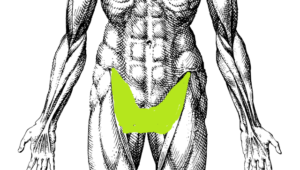The human body is a marvel of complexity, with each part playing a vital role in our overall well-being. Among the many fascinating areas we often overlook is the groin. Nestled between the abdomen and the thigh, the groin is a crucial anatomical region that holds great significance. In this article, we will delve into the location and importance of the groin in the human anatomy, shedding light on its functions and the impact it has on our daily lives. From its role in facilitating movement and supporting our skeletal structure to its involvement in the reproductive and urinary systems, the groin is intricately connected to various aspects of our health. So, join us as we uncover the secrets of this often-underappreciated part of our body and gain a deeper understanding of its significance in maintaining our overall well-being.
Anatomy of the groin area
The groin area, also known as the inguinal region, is located on each side of the lower abdomen. It extends from the pubic bone to the crease between the thigh and the abdomen. The groin consists of several structures, including muscles, tendons, blood vessels, lymph nodes, and nerves.
One of the main components of the groin area is the inguinal canal, which is a passage that allows structures, such as blood vessels and nerves, to pass through. It is a common site for hernias, where an organ or tissue protrudes through the weakened abdominal wall.
The groin area is also home to lymph nodes, which are small, bean-shaped glands that play a vital role in the immune system. They help filter and trap harmful substances, such as bacteria and viruses, preventing them from spreading further into the body.
Muscles and tendons
The groin area is home to several muscles and tendons that play a crucial role in movement and stability. One of the main muscles in the groin is the adductor muscle group, which consists of five muscles: the adductor longus, adductor brevis, adductor magnus, gracilis, and pectineus.
These muscles are responsible for adduction, which is the movement that brings the leg toward the midline of the body. They also help stabilize the hip joint during activities such as walking, running, and jumping. Additionally, the groin area is home to the iliopsoas muscle, which is a major hip flexor.
The tendons in the groin area connect the muscles to the bones. They provide strength and stability during movement. The adductor tendons, in particular, play a crucial role in the proper functioning of the groin area.
The role of the groin in human movement
The groin area plays a significant role in facilitating movement and supporting our skeletal structure. During activities such as walking, running, or even sitting, the muscles in the groin area work in harmony with other muscles to provide stability and control.
The adductor muscles are responsible for bringing the legs together and maintaining balance. They assist in movements such as crossing the legs, kicking a ball, or changing direction while running. These muscles also play a vital role in maintaining proper alignment of the legs and pelvis, reducing the risk of injuries.
Moreover, the area is involved in the movement of the hip joint. The iliopsoas muscle, located in the groin, is responsible for flexing the hip joint, allowing us to lift our legs and move them forward during activities such as walking or climbing stairs.
Common injuries and conditions affecting the groin
Despite its importance, the groin area is susceptible to various injuries and conditions. One of the most common injuries in the groin area is a groin strain, also known as a pulled groin muscle. This occurs when the muscles in the groin area are stretched beyond their limits, resulting in small tears in the muscle fibers.
Groin strains often occur during activities that involve sudden movements, such as sprinting, jumping, or kicking. Symptoms of a groin strain may include pain, swelling, and difficulty in moving the leg.
Another common condition that affects the groin area is a hernia. A hernia occurs when an organ or tissue protrudes through a weak spot in the abdominal wall, often in the inguinal canal. This can cause pain, discomfort, and a visible bulge in the groin area.
In addition to strains and hernias, the groin area can also be affected by conditions such as osteoarthritis, bursitis, and tendinitis. These conditions can cause pain, inflammation, and limited mobility in the area.
When experiencing pain or discomfort in the groin area, A healthcare professional assesses with physical examination, assessing the range of motion, strength, and stability of the groin area.
In some cases, additional diagnostic tests may be required to determine the exact cause of the symptoms. These tests may include imaging studies, such as X-rays, ultrasound, or magnetic resonance imaging (MRI).
Treatment options for groin injuries
The treatment for injuries and conditions depends on the underlying cause and severity of the symptoms. Conservative treatment options for groin strains may include rest, ice, compression, and elevation (RICE), along with pain medication and physical therapy.
For more severe strains or injuries, a healthcare professional may recommend more advanced treatments, such as corticosteroid injections or even surgery. Surgical interventions may be necessary for conditions such as hernias, where the protruding tissue needs to be repaired and the weakened abdominal wall reinforced.
Rehabilitation exercises play a crucial role in the recovery and strengthening of the area after a n injury. These exercises focus on improving flexibility, stability, and muscle strength in the groin and surrounding areas.
n injury. These exercises focus on improving flexibility, stability, and muscle strength in the groin and surrounding areas.
Rehabilitation by qualified healthcare professional suggest exercises for the groin including adductor stretches, hip flexor stretches, and strengthening exercises such as side-lying leg lifts and squats.
Preventing groin injuries
Prevention is key when it comes to groin injuries. Taking certain precautions can help reduce the risk of strains, hernias, and other injuries to the groin area. Some preventive measures include:
– Proper warm-up and stretching before physical activities
– Using proper techniques and form during exercises and sports
– Gradually increasing the intensity and duration of physical activities
– Wearing appropriate protective gear, such as supportive athletic shoes
– Maintaining a healthy weight to reduce stress on the groin area
– Listening to your body and taking breaks when needed to prevent overuse injuries
The groin area, often overlooked, is a crucial part of the human anatomy. Its location and importance become evident when we understand its role in movement, stability, and the proper functioning of the skeletal structure. From facilitating everyday activities to supporting the reproductive and urinary systems, this area plays a significant role in our overall well-being.
